Deseja adicionar a verificação em duas etapas do Google Authenticator ao seu site WordPress?
As senhas por si só não são suficientes para afastar hackers e usuários não autorizados. Felizmente, o uso da verificação em duas etapas do Google Authenticator pode adicionar uma camada extra de segurança ao seu site.
Neste artigo, mostraremos como adicionar a verificação em duas etapas ao seu site WordPress usando o aplicativo Google Authenticator.
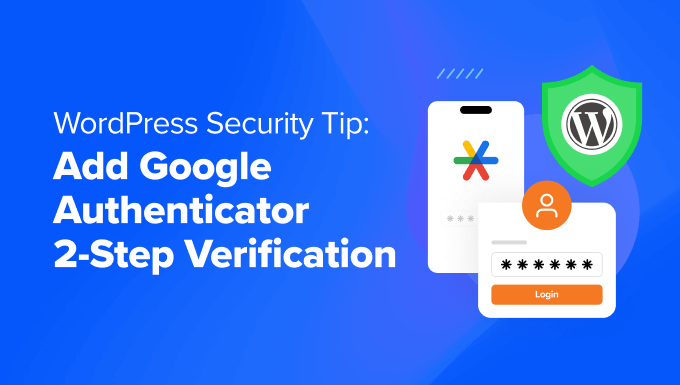
O que é o aplicativo Google Authenticator e por que você precisa dele para seu site WordPress?
O aplicativo Google Authenticator é um aplicativo móvel que adiciona uma segunda camada de autenticação sempre que você faz login em um aplicativo ou site de terceiros, como o WordPress.
Infelizmente, às vezes as senhas podem ser decifradas. Se você estiver usando a mesma senha em vários sites, um vazamento de segurança em um deles colocará suas outras contas em perigo. Muitas vezes, as pessoas são preguiçosas e não alteram suas senhas mesmo depois de receberem um e-mail sobre uma falha de segurança em um site importante.
Bem, a verificação em duas etapas é a solução para isso. Mesmo que o hacker saiba o seu nome de usuário e a sua senha do WordPress, ele não poderá acessar o seu site do WordPress, a menos que tenha um código de segurança aleatório com restrição de tempo (fornecido pelo Google Authenticator).
Como o blog está diretamente conectado ao seu dispositivo móvel, você será a única pessoa com acesso para recuperar o código exclusivo para cada login. O código expira em um curto período de tempo por motivos de segurança.
O aplicativo Google Authenticator é apenas um exemplo de aplicativo móvel que fornece autenticação de dois fatores (2FA) para várias contas e serviços on-line.
Ele gera senhas de uso único baseadas em tempo (TOTPs) que servem como segundo fator de autenticação ao fazer login em uma conta.
Se você ainda não está convencido da importância da segurança do WordPress, então deve ver como a vida digital de um dos autores da Wired.com foi destruída.
Depois de ler essa história, passamos a usar a autenticação em duas etapas em nossas contas do Google e na maioria dos outros serviços que oferecem esse recurso. Se você é tão preocupado com a segurança quanto nós e valoriza seu blog, siga esta dica para aumentar a segurança do WordPress.
Observação: o Google Authenticator só funciona em dispositivos iOS, Android, Windows Phone, webOS, PalmOS e BlackBerry. Em outras palavras, você precisará do seu smartphone para fazer login no seu site.
Para aumentar ainda mais sua segurança, recomendamos que você procure outros métodos também. Por exemplo, um software como o 1Password pode ajudá-lo a gerenciar suas senhas em um único lugar e garantir que elas sejam fortes o suficiente para resistir a possíveis hackers.
Dito isso, vamos começar o tutorial sobre como adicionar a verificação em duas etapas do Google Authenticator ao seu site WordPress.
Como adicionar o Google Authenticator no WordPress
A primeira coisa que você precisa fazer é instalar o aplicativo Google Authenticator no seu telefone. Para este tutorial, usaremos a terminologia iOS, mas o processo também é semelhante para outros dispositivos.
Etapa 1: Instale o aplicativo Google Authenticator em seu dispositivo móvel
Visite a App Store, pesquise “Google Authenticator” e clique em “Install” (Instalar) para o aplicativo.
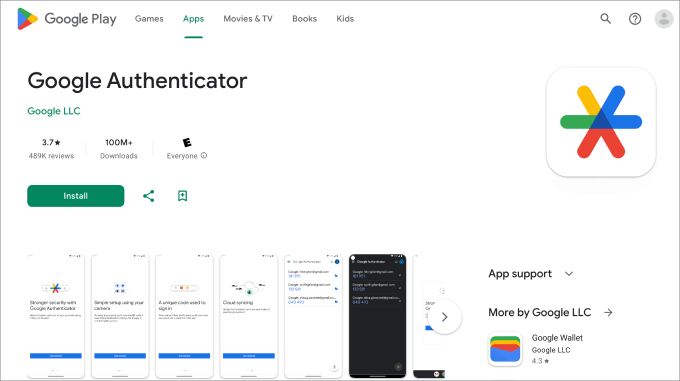
Agora, vamos voltar ao painel do WordPress.
Etapa 2: Instale o plug-in do Google Authenticator da MiniOrange
Vá em frente, instale e ative o plug-in do Google Authenticator da MiniOrange. Para obter mais detalhes, consulte nosso guia passo a passo sobre como instalar um plug-in do WordPress.
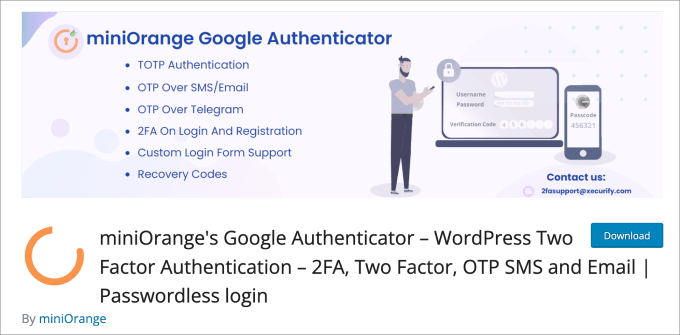
Esse é um plug-in gratuito para WordPress que ajuda a proteger seu site contra acesso não autorizado. Sempre que fizer login no WordPress, será solicitado que você digite a senha de uso único do aplicativo Google Authenticator para verificar sua identidade.
Após a ativação do plug-in, você será levado a um assistente de configuração. Basta seguir o processo para configurar a autenticação de dois fatores do Google Authenticator no WordPress.
Etapa 3: Concluir o assistente de configuração
Comece clicando no botão “Let’s get started!” (Vamos começar!).
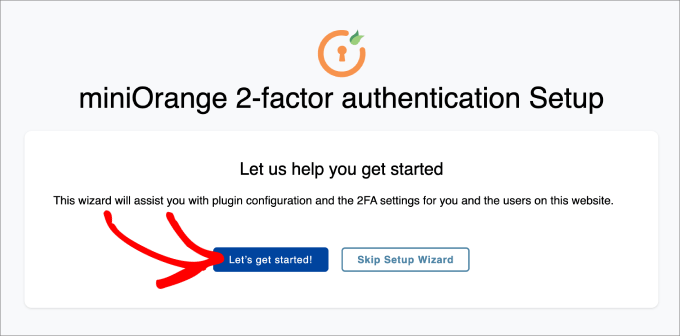
Em seguida, será perguntado se você deseja configurar a 2FA após o primeiro login ou no painel do plug-in. Qualquer um dos métodos é adequado.
Clique em “Continue Setup” (Continuar configuração).
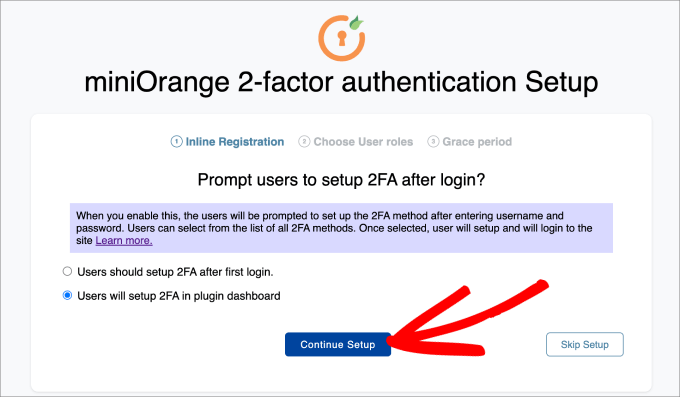
A próxima etapa é escolher a quem você deseja que a 2FA se aplique. É possível selecionar todos os usuários para obter segurança máxima ou aplicar a 2FA somente a determinadas funções de usuário.
Em seguida, clique em “Continue Setup” (Continuar configuração).
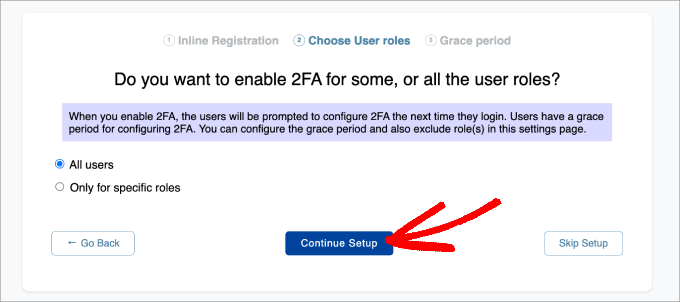
Por fim, será perguntado se você deseja ou não aplicar diretamente a 2FA imediatamente ou dar aos usuários um período de tolerância.
Se optar por dar aos usuários um período de carência, poderá selecionar a duração desse período em horas e dias. Quando isso for concluído, clique em “All Done”.
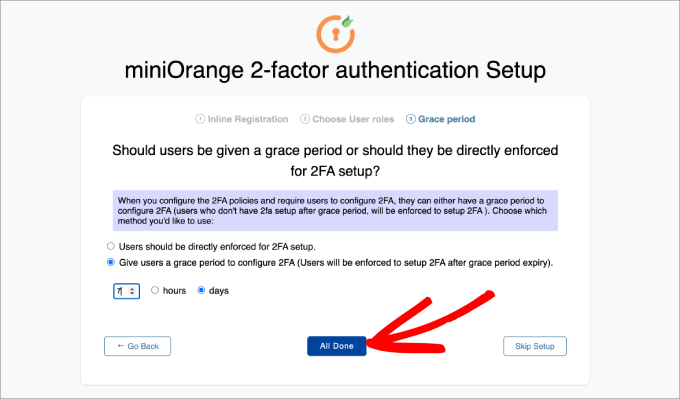
Agora que você concluiu o processo de configuração, pode decidir se deseja configurar a 2FA para si mesmo agora ou mais tarde.
Vá em frente e clique no botão “Configure 2FA for yourself” (Configurar 2FA para você).
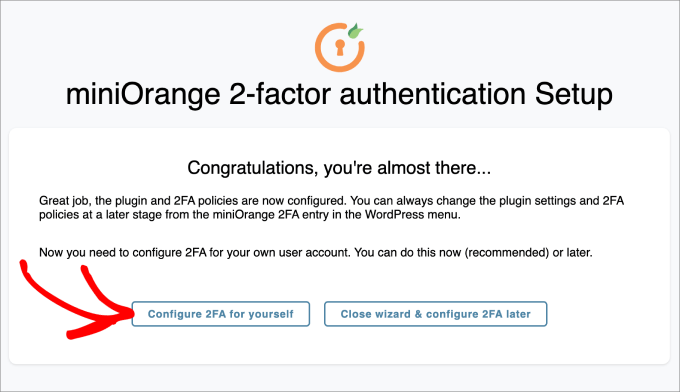
A partir daí, você será solicitado a inserir o método de autenticação de dois fatores que deseja adicionar ao seu site WordPress.
Para este tutorial, escolheremos “Google/Microsoft/Authy Authenticator”. Em seguida, basta pressionar o botão “Save & Continue”.
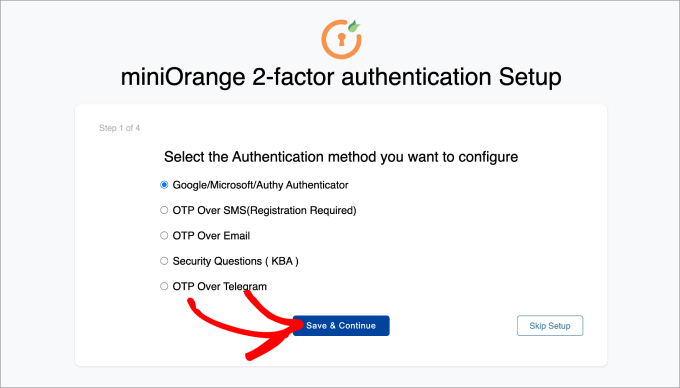
Em seguida, será solicitado que você escaneie o código de barras na tela. Isso significa que você terá que abrir o aplicativo Google Authenticator no seu telefone e escanear o código de barras exibido.
No aplicativo Google Authenticator em seu dispositivo móvel, clique no ícone “+” na parte inferior e selecione “Scan a QR code”. Em seguida, aponte a câmera do telefone para a tela do computador para digitalizar o código de barras.
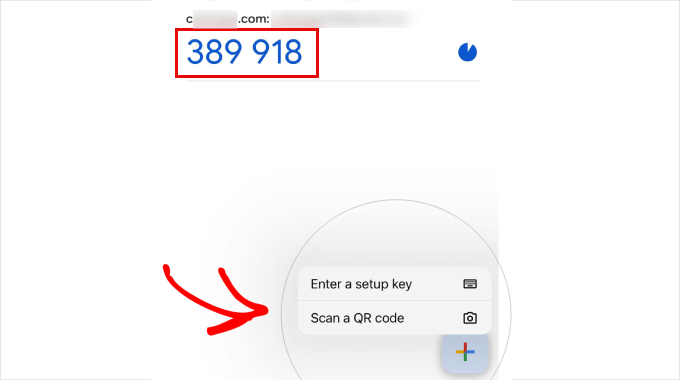
A partir daí, uma senha de uso único (OTP) será exibida em seu dispositivo móvel.
Digite isso na etapa 2 em seu computador. A partir daí, você pode clicar em ‘Save & Continue’.
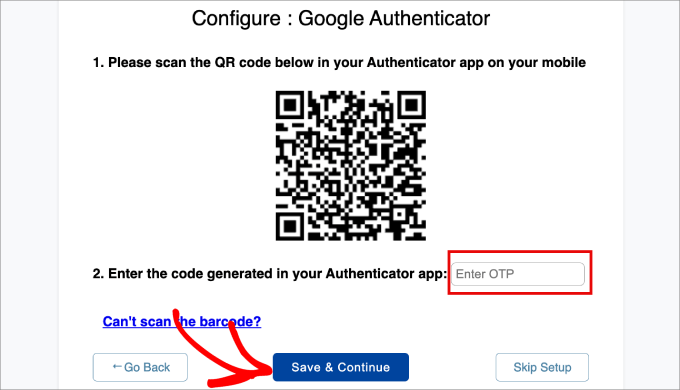
Agora, você deve receber uma mensagem informando que configurou a autenticação de dois fatores com êxito.
Basta selecionar “Advance Settings” (Configurações avançadas).
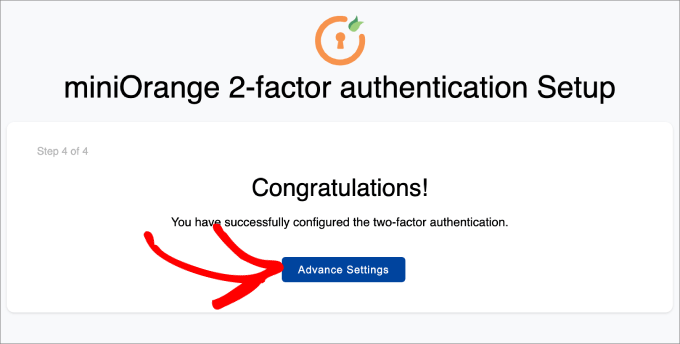
Etapa 4: Adicionar perguntas de segurança
Além de adicionar a autenticação de dois fatores do Google Authenticator, é provável que você também queira adicionar perguntas de segurança.
Se não conseguir acessar o aplicativo Google Authenticator, você ainda poderá fazer login no site do WordPress se responder às perguntas de segurança que definiu para si mesmo.
Você precisará ir até a página Mini Orange 2-Factor ” Two Factor no painel de administração do WordPress. Em seguida, na guia Setup 2FA For Me (Configurar 2FA para mim), localize o método Security Questions (Perguntas de segurança) e clique em ‘Reconfigure’ (Reconfigurar).
Lembre-se de que você também pode configurar outros tipos de métodos de autenticação de dois fatores, como verificação de e-mail, OTP por SMS, OTP por e-mail, OTP por Telegram e até mesmo o Duo Authenticator.
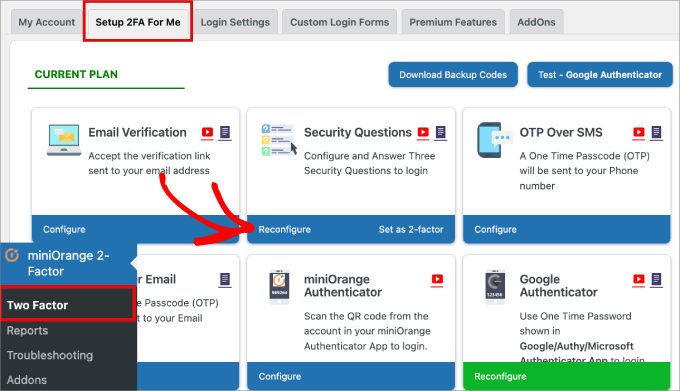
Em seguida, você poderá selecionar até três perguntas de segurança. Você pode selecionar duas delas em um menu suspenso, e a terceira será uma pergunta personalizada que você pode criar por conta própria.
Em seguida, digite a resposta para cada uma delas e pressione o botão “Save” (Salvar).
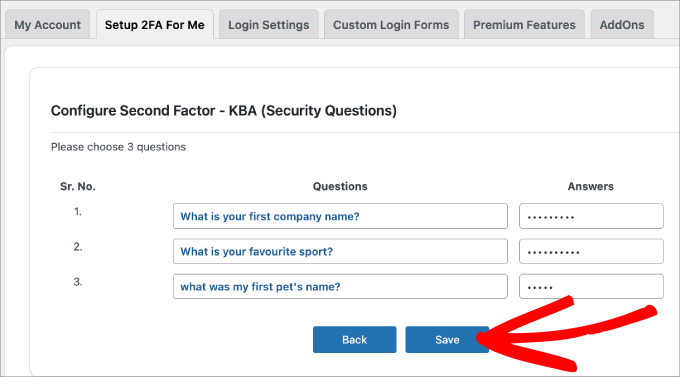
Etapa 5: Teste você mesmo
Quando tudo estiver configurado, você poderá testá-lo por conta própria.
Basta fazer logout do painel do WordPress e tentar fazer login novamente.
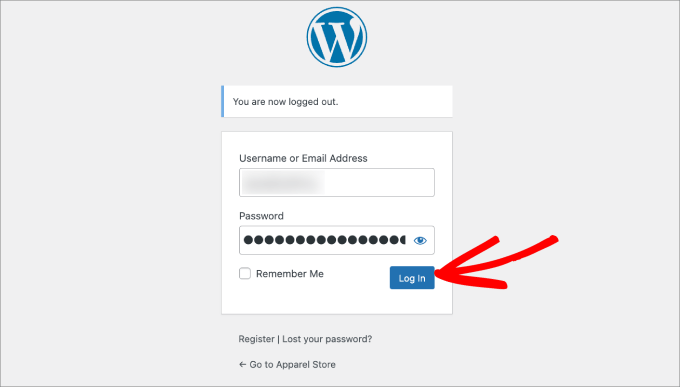
Você será levado a uma página em que poderá responder a perguntas de segurança ou usar o Google Authenticator para inserir sua senha de uso único.
Vá em frente e selecione a opção “Google Authenticator”.
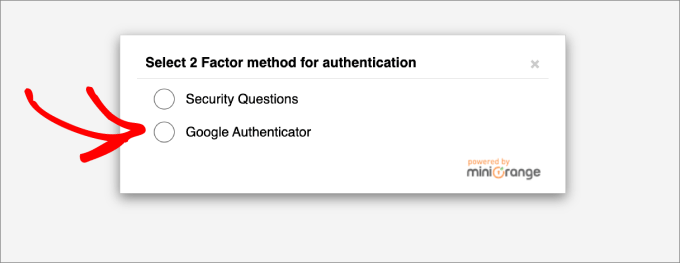
Nessa tela, será solicitado que você insira sua OTP do aplicativo Google Authenticator.
Digite o código e clique em “Validate” (Validar).
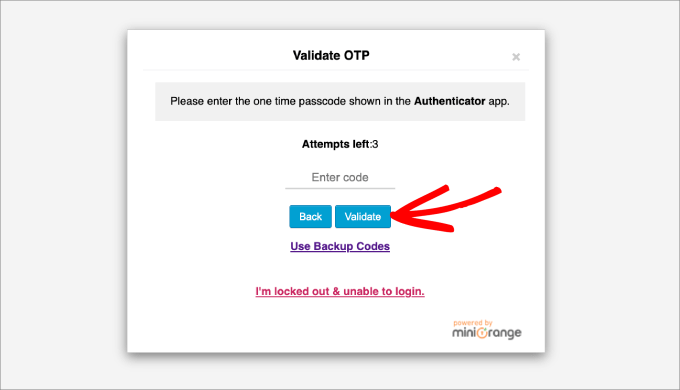
Agora, você voltará ao painel de administração do WordPress, como de costume.
Por fim, recomendamos que todos ativem a verificação em duas etapas em suas contas do Google. Você também pode configurar isso com o Google Authenticator, conforme mostrado neste tutorial.
Esperamos que este artigo tenha ajudado você a adicionar a verificação em duas etapas do Google Authenticator ao seu site WordPress. Talvez você também queira dar uma olhada em nosso artigo sobre os erros mais comuns do WordPress e como corrigi-los ou em nosso guia definitivo para aumentar a velocidade e o desempenho do WordPress.
Se você gostou deste artigo, inscreva-se em nosso canal do YouTube para receber tutoriais em vídeo sobre o WordPress. Você também pode nos encontrar no Twitter e no Facebook.





David
I just tried this and it locked me out of my website. The codes weren’t working. How can I remove this authenticator and get my site back. Pls help
WPBeginner Support
You can deactivate the plugin following our guide below:
https://www.wpbeginner.com/beginners-guide/how-to-easily-deactivate-wordpress-plugins/
Admin
ANOOP VAISH
what have to do if mobile lost please discribe
WPBeginner Support
Hi Anoop,
In that case you will have to deactivate WordPress plugins via FTP to login.
Admin
yasir khan saqlaini
i am using this feature but i want to know how will i get google authenticator code while login wp dashbord.
WPBeginner Support
Hello Yasir,
You will get Google Authenticator code inside the app you installed on your phone.
Admin
Danny D
I’m surprised that nobody has mentioned Clef. This is the best 2-factor authentication for WordPress (and a lot of other websites as well). No passwords involved after initial setup. They have iOS and Android apps as well as chrome extensions to help with the setup. Works like a charm for me.
Sacha
I agree – I absolutely love Clef. It makes things so easy and secure.
rohit
Message To Syed Balkhi,
Well Fake GURUs Try to hack my website 100 Times a day Finally I have started using Google Authenticator and I change my Password every 10 days. I appreciate Your skills Thanks a lot.
Akhil K A
Hi.
The plugin is compatible up to WP 3.8.8
Can I install on the latest version?
Thanks.
WPBeginner Support
Yes you can. Please see, Should you install plugins not tested with your WordPress version.
Admin
Erick Perez
you guys don’t use this on your own website, how come?
handi priyono
Hello dude,, thanks for help me by writting this useful post.
this post very help me to prevent hacker to login to my web. thanks !!
WPBeginner Staff
Please contact WordPress.com support.
WPBeginner Staff
You can deactivate the plugin using an FTP client. See our guide on how to disable all plugins using FTP without wp-admin access.
Kavitha Krishnan
I am using the WP.com hosting. So this option will not work for me.
Kavitha Krishnan
Hi, I have uninstalled the Google app by mistake now i am unable to login to WP. i requested the account recovery also nothing worked. Is there any solution for my issue.
Sriram
Hi,
What if I have a custom login page? How can I integrate this plugin in my custom login page?
Lorena Dennison
I have my wordpress blog set up to receive a SMS code to log in… well my cell phone is shut off and can’t get the SMS Code…. so how can I log in and take that SMS off my blog?
WPBeginner Support
You can’t unless you disable the plugin used to enable this two step authentication.
Admin
Kamran Abdul Aziz
Aha, Google Authenticator & Authy they always works for me,
However is there any option where we can force users to use 2 Step verification?
Am not allowing my users to access the Backend, Their profile & everything is limited to front end only.
I don’t want them to access their backend & Setup 2 step.
Any solutions?
Brenda
I installed the two-step google authenticator, both the app and the plugin. I updated the app and now all of the sudden I can’t generate a verification code, and therefore have not been able to login to my WordPress. I have no idea what “login using FTP” or who my webmaster is. I signed up for a free worpress account because I wanted to start a little blog and now it appears to me I have to be a computer wizard to do something so basic, which is login!! Can you please help? And explain it to me like I’m a third grader. I don’t have the tech savviness you all do.
Thank you in advance
WPBeginner Support
You mentioned that you have a free WordPress account. Does your blog address has wordpress.com in it? If that’s the case, then this tutorial is not for you. You need to contact WordPress.com support for assistance.
Admin
Zulfa Permata Suri
I have set up two-step authentication for my wordpress blog. Suddenly I cant log-in it said the authentication code that i type is invalid and now I am locked out of my wordpress account.
Help me please, I want to use my wordpress but I cant log-in T.T
Editorial Staff
Login to WordPress using FTP and delete the plugin.
Admin
Alyson
Hi – I lost my phone with my google authenticator on it and now I can’t get into my site. I don’t know how to log in using ftp ..
HELP?
Thanks!
Editorial Staff
Contact your webhosting provider. They’re the only one who have your FTP access and can help delete the plugin.
Cara Isaacs
Hey,
I recently set up two-step authentication for my wordpress blog. Downloaded the google app and it all worked fine with log-in. Then changed the name of my blog and accidentally deleted the google authenticator app and now I am locked out of my wordpress account as it asks for the code yet I cannot generate a code because I can’t access my account to get the key.
I hope you can help.. PLEASE!
Editorial Staff
Use FTP to delete the plugin.
Admin
Cara
Thanks for your reply. I just downloaded the ftp software except it can’t seem to connect to the server. Looks like I will be starting a new blog…
Editorial Staff
Hey Cara. Starting a new blog is not a good solution. Please get in touch with your hosting provider or send us an email. We can help you restore this and get it sorted out.
Everett Patterson
Well I did some research and found that the hosting time may be different than the phone time and may cause issues with the codes.
I was able to log in to my Cpanel and delete the plugin. I still want to use it though so I added it back in and used the relaxed mode this time. Seems to be working now.
Thanks for this post, very helpful.
Everett Patterson
Uh Oh. I locked myself out of my site.
Here’s what I did:
Added the plugin to my blog
Activated it, but didn’t check the “Active” box
Added authenticator to my android
Scanned the QR code
Checked “Active” box
Signed out
My phone gives me a new code every minute, but none of them work. What now?
Austin
I did this too…. I logged into my host via FTP and deleted the Google Authenticator plugin.
Then I went through the process again and the plugin/app combo worked like a charm!
Hope you’re able to get back into your site (if you haven’t already).
Maria Muir
I installed the plugin, followed the simple steps and have now been locked out of my site. I also have the failed attempt log in plugin which has blocked me for 3 failed attempts so now have to wait. I did put in the correct details and authentication code, I tripled checked the installation and settings, all are correct. So why can’t I log back in?
Editorial Staff
Run this plugin in the relaxed mode.
Admin
Chris Burbridge
It does concern me that when you install the plugin, you have to activate it user by user. That doesn’t make sense to me. Wouldn’t an administrator want to have it work for all users, otherwise there are holes in the net?
I have been trying this one, which is really great — http://wordpress.org/extend/plugins/duo-wordpress/ — there’s a free option, and it works similarly. It is very slick, with a smart phone.
Editorial Staff
The reason why Google Authenticator requires each user to enable it themselves is because they have to connect their device with it. Google Authenticator is a great solution if you don’t like paying for a service. We are using it on our site. All we did was send an email to all users and ask them to turn it on.
Yes it requires a little bit of extra work, but it is surely worth it for a small company like ours. If you have hundreds of people in your team, then it would be worth to automate it with a service like the one you linked.
Admin
Michael
This works great with Limit Login Attempts plug in. Great security feature if your blog does not have SSL capabilities.
yatin
i love your site very helpful
very helpful
what if Google authenticator app got uninstalled by mistake !!!!
after that how can i login in my wordpress site ?
Editorial Staff
Delete the plugin. Then re-do the process.
Admin
Gerard
Good article, good plugin and good subject
Love Authenticator app.
Kind regards,
Gerard.
Umer Rock
Buy Syed bro it is not linked to google account ? then why you used google athenticator word , i think it is kind of 2 step verification system only,
Editorial Staff
If you read the post carefully, you will see that the app this plugin uses is called Google Authenticator. Without using that application this would not work. If you actually follow the tutorial and download the application, then you will see that application is made by Google Inc.
Admin
Hadley
I was able to successfully set up the Google Authenticator app for myself as an admin on my site, but was not able to set it up successfully for an editor on the same site. On the other user’s profile settings under Google Authenticator, the only options are to hide the Authenticator settings or make the user active with Google Authenticator. There aren’t the same options to type in a site description or view a secret code. After installing the app successfully to the other user’s phone, she was not able to sign in to the site and I’m wondering if this is due to the profile settings. Any advice?
Editorial Staff
Interesting. It is probably best to contact the plugin author and see what the issue could be.
Admin
Ahmad Awais
Putting our login authentication in hands of a 3rd party plugin?
Not more than 5k Downloads! What about its authenticity? Are you using it yourself #justcurious.
I am happy with .htpaswrd file.
Should we trust this code?
Except this a nice plugin for sure.
Editorial Staff
The plugin has low downloads because not many people have jumped on board with this 2-step verification method. If you are happy with .htpaswd, then good for you. Yes, we are using it on our site along with all the other security measures.
Admin
Dilawer Pirzada
Buzz! After my great efforts on securing WordPress blog from spammers and hackers, I myself today found a great plugin to stop hackers!
Thanks for the plugin!
Santel Phin
Hi,
I have completed the setup and it works great. But do I have possibility to choose how to the verification code.
I did the same setup for my Google account, but it send via SMS in stead. And I do prefer this mode as well if it is possible.
But I don’t see any setting to chose send via SMS. Hope you can give me an idea if it is possible or not.
Thanks
Editorial Staff
No the SMS option is not available. Mainly because for that you need a sending service which blogs are not equipped with. There is another plugin called “2-step verification” that has the option to email the code. But no SMS.
Admin
Navneet Singh
Plugin looking simple and POWERFUL.!!
Saad
This Will Be Useful For Stopping Brute Force
Geoffrey Gordon
Thanks Syed
WordPress security has always been a big issue in general, so the more educated people are regarding WordPress security the better. This is especially important as people see WordPress as a quick way to get a website up and running. Then one day without warning BANG their website is down by some hacker.
Busy checking out the Google authentication plugin for WordPress, looks good. I have ask though with all the security plugin’s installed on ones blog plus other plugins it tends to slow down the website. Sometimes its better to code what a plugin can do straight into your blog, rather than keep adding another plugin.
Editorial Staff
This plugin works in the backend, so it will not have an impact on your site’s load time on the front-end.
Admin
Landfoci
Good plugin. Thanks your share